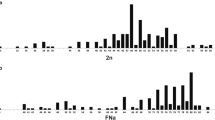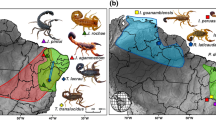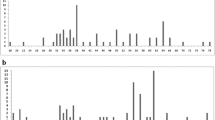Abstract
Chromosomal studies in three species of Amazonian Callithrix (2n=44) and data in the literature show that this group is karyomonotypic. Moreover, it is characterized by the presence of abundant heterochromatic regions, unlike the situation in congeneric forms of Callithrix of the Atlantic coast with 2n=46, and by the presence of a highly repetitive, exclusive DNA component, with a basic repeat motif of 1528 bp. Karyotypic comparisons with other Callitrichids and an outgroup species showed that Callitrichids are karyologically conserved and explained several rearrangements that had presumably occurred during their phyletic radiation. Analyses of karyologic data enabled the construction of two alternative phylogenetic topologies. The lack of derived homoeologies, common to all members of the genus Callithrix grouped at present, and the fact that Amazonian species were more similar to Cebuella pygmaea (2n=44) than to their congeneric forms with 2n=46 suggested that species at present included in the Amazonian Callithrix should be grouped with C. pygmaea.
Similar content being viewed by others
References
Alves G (1994) DNA satélite em 5 espécies de primatas neotropicais. PhD dissertation, Universidade Federal do Rio de Janeiro, Rio de Janeiro
Alves G, Canavez F, Seuánez HN, Fanning T (1995) Recently amplified satellite DNA in Callithrix argentata (Primates, Platyrrhini). Chromosome Res 3:207–213
Armada JL, soares VMFC, Seuánez HN (1982) Chromosome number of Callithrix jacchus flaviceps (Thomas 1903). Lab Primate Newslett 21:1–3
Barros RMS, Nagamachi CY, Pieczarka JC (1990) Chromosomal evolution in Callithrix emiliae. Chromosoma 99:440–447
Benirschke K, Anderson JM, Brownhill LE (1962). Marrow chimerism in Marmosets. Science 138:513–515
Felsenstein J (1989) PHYLIP-phylogeny interference package, version 3.2. Cladistics 5:164–166
Ford SM (1980) Callitrichids as phyletic dwarfs, and the place of the Callitrichidae in the Platyrrhini. Primates 21:31–43
Hershkovitz P (1977) Living New World monkeys (Platyrrhini), vol 1. University of Chicago Press, Chicago
Hsu TC, Hampton SH (1970) Chromosomes of Callitrichidae with special reference to an XX/XO sex chromosome system in Goeldi's marmosets (Callimico goeldii, Thomas 1904). Folia Primatol 13:183–195
Ma NSF, Jones TC, Miller A, Morgan L, Adams E (1976) Chromosome polymorphism and banding patterns in the owl monkey (Aotus). Lab Anim Sci 26:1022–1036
Meirelles CMM, Sampaio MIC, Schneider H, Schneider MPC (1992) Protein variation, taxonomy and differentiation in five species of Marmosets (genes Callithrix Erxleben 1777). Primates 33:227–238
Mittermeier RA, Rylands AB, Coimbra-Filho AF (1988) Systematics: species and subspecies — an update. In: Mittermeier RA, Rylands AB, Coimbra-Filho AF, Fonseca GAB (eds) Ecology and behavior of neotropical primates, vol 2. World Wildlife Fund, Washington, DC, pp 13–75
Nagamachi CY, Pieczarka JC, Schwarz M, Paiva CMC, Barros RMS, Mattevi MS (1994) Karyotype of Callithrix mauesi (Callitrichidae, Primates) and its relation to those of Callithrix emiliae and Callithrix jacchus. Am J Primatol 33:121–132
Napier JR, Napier PH (1967) A handbook of living primates. Academic Press, London
Natori M (1994) Craniometrical variations among eastern Brazilian Marmosets and their systematic relationships. Primates 35:167–176
O'Brien SJ, Seuánez HN, Womack JE (1985) On the evolution of genome organization in mammals. In: MacIntyre RJ (ed) Molecular evolutionary genetics (Monographs in evolutionary biology series). Plenum Press, New York, pp 519–589
O'Brien SJ, Seuánez HN, Womack JE (1988) Mammalian genome organization: an evolutionary view. Annu Rev Genet 22:323–351
Rylands AB, Coimbra-Filho AF, Mittermeier RA (1993) Systematics, geographic distribution, and some notes on the conservation status of the Callitrichidae. In: Rylands AB (ed) Marmosets and Tamarins Systematics, behavior, and ecology. Oxford University Press, Oxford
Rosenberger AL (1981) Systematics: the higher taxa. In: Mittermeier RA, Coimbra-Filho AF (eds) Ecology and behavior of neotropical primates. Academia Brasileira de Ciências. Rio de Janeiro
Sambrook J, Fritsch EF, Maniatis T (1989) Molecular cloning: a laboratory manual. Cold Spring Harbor Laboratory Press, Cold Spring Harbor, NY
Sanich VM, Cronin JE (1980) South American mammal molecular systematics, evolutionary clocks and continental drift. In: Ciochon R, Chiarelli AB (eds) Evolutionary biology of the New World monkeys and continental drift. Plenum Press, New York, pp 399–421
Schneider H, Schneider MPC, Sampaio I, Harada ML, Stanhope M, Czelusniak J, Goodman M (1993) Molecular phylogeny of the New World monkeys (Platyrrhini, Primates). Mol Phylogenet Evol 2:225–242
Seabright M (1971) A rapid technique for human chromosomes. Lancet 2:971–972
Seuánez HN, Forman L, Alves G (1988) Comparative chromosome morphology in three Callitrichid genera: Cebuella, Callithrix, and Leontopithecus. J Hered 79:418–424
Seuánez HN, Forman L, Matayoshi T, Fanning TG (1989) The Callimico goeldii (Primates, Platyrrhini) genome: karyology and middle repetitive (LINE-1) DNA sequences. Chromosoma 98:389–395
Simpson GG (1945) The principles of classification of mammals. Am Museum Nat Hist 85:1–350
Sumner AT (1972) A simple technique for demonstrating centromeric heterochromatin. Exp Cell Res 75:304–306
Vivo M (1991) Taxonomia de Callithrix Erxleben, 1777 (Callitrichidae, Primates). Fundação Biodiversitas para conservação da Biodiversidade Biológica, Belo Horizonte
Author information
Authors and Affiliations
Rights and permissions
About this article
Cite this article
Canavez, F., Alves, G., Fanning, T.G. et al. Comparative karyology and evolution of the Amazonian Callithrix (Platyrrhini, Primates). Chromosoma 104, 348–357 (1996). https://doi.org/10.1007/BF00337224
Received:
Revised:
Accepted:
Issue Date:
DOI: https://doi.org/10.1007/BF00337224




